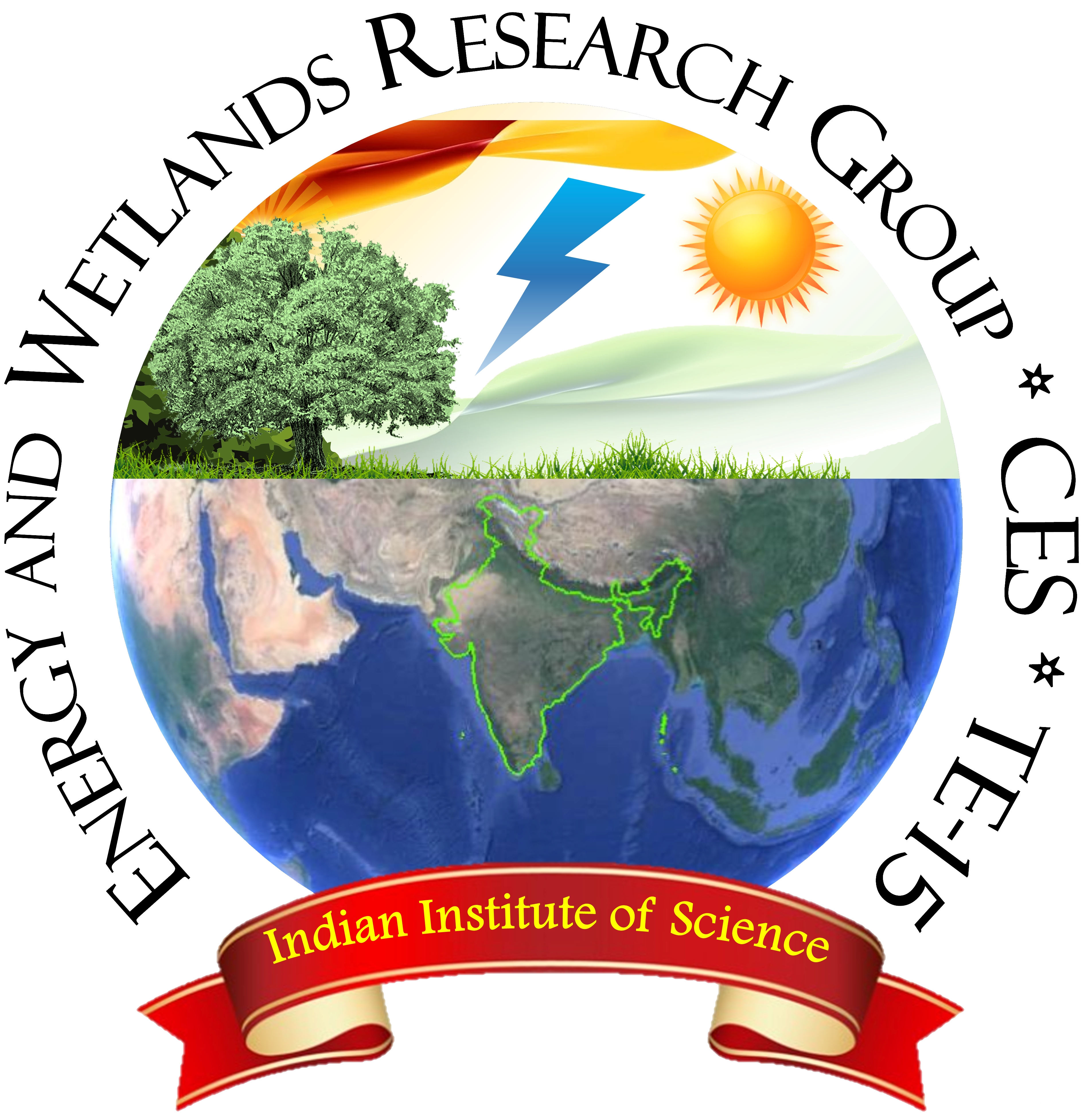
|
Carbon sequestration potential of the forest ecosystems in the Western Ghats, a global biodiversity hotspot
|

|
1Energy and Wetlands Research Group, Centre for Ecological Sciences [CES],
Indian Institute of Science, Bangalore – 560012, India.
2 Centre for Sustainable Technologies [CST], Indian Institute of Science.
3Centre for Infrastructure, Sustainable Transport and Urban Planning [CiSTUP],
Indian Institute of Science, Bangalore 560 012.
*Corresponding author: trv@iisc.ac.in
References
- Achat, D.L., Fortin, M., Landmann, G., Ringeval, B., & Augusto, L., (2015). Forest soil carbon is threatened
by intensive biomass harvesting. Scientific reports, 5, 15991. https://doi.org/10.1038/srep15991
- Agrawal, A., Nepstad, D., & Chhatre, A., (2011). Reducing emissions from deforestation and forest
degradation. Annual Review of Environment and Resources, 36, 373-396. https://doi.org/10.1146/annurev-environ-042009-094508
- Alkama, R., & Cescatti, A., (2016). Biophysical climate impacts of recent changes in global forest
cover. Science, 351(6273), 600-604. https://doi.org/10.1126/science.aac8083
- Armenteras, D., Murcia, U., González, T.M., Barón, O.J., & Arias, J.E., (2019). Scenarios of land use and
land cover change for NW Amazonia: Impact on forest intactness. Global Ecology and Conservation, 17,
e00567. https://doi.org/10.1016/j.gecco.2019.e00567
- Arsanjani, J.J., Helbich, M., Kainz, W., & Boloorani, A.D., (2013). Integration of logistic regression,
Markov chain and cellular automata models to simulate urban expansion. International Journal of Applied
Earth Observation and Geoinformation, 21, 265-275. https://doi.org/10.1016/j.jag.2011.12.014
- Atkinson, G., & Gundimeda, H., (2006). Accounting for India's forest wealth. Ecological Economics, 59(4),
462-476. https://doi.org/10.1016/j.ecolecon.2005.10.022
- Bala, G., Caldeira, K., Wickett, M., Phillips, T.J., Lobell, D.B., Delire, C., & Mirin, A., (2007). Combined
climate and carbon-cycle effects of large-scale deforestation. Proceedings of the National Academy of
Sciences, 104(16), 6550-6555. https://doi.org/10.1073/pnas.0608998104
- Bellassen, V. and Luyssaert, S., 2014. Carbon sequestration: Managing forests in uncertain times. Nature
News, 506(7487), 153-155. https://doi.org/10.1038/506153a
- Bharath, S., Rajan, K.S., & Ramachandra, T.V., (2014). Status and future transition of rapid urbanizing
landscape in central Western Ghats - CA based approach. ISPRS Annals of Photogrammetry, Remote Sensing &
Spatial Information Sciences, 2(8), 69–75. https://doi.org/10.5194/isprsannals-II-8-69-2014
- Bonan, G.B., (2008). Forests and climate change: forcings, feedbacks, and the climate benefits of forests. Science, 320(5882),
1444-1449. http://doi.org/10.1126/science.1155121
- Canziani, P.O., & Gerardo, C.B., (2012). Climate impacts of deforestation/land-use changes in central South
America in the PRECIS Regional Climate Model: mean precipitation and temperature response to present and future
deforestation scenarios. The Scientific World Journal, 2012, 1-20. https://doi.org/10.1100/2012/972672
- Chandran, M.D.S., Rao, G.R., Gururaja, K.V., & Ramachandra, T.V., (2010). Ecology of the swampy relic
forests of Kathalekan from Central Western Ghats, India. Bioremediation, Biodiversity and
Bioavailability, 4(1), 54-68.
- Damandeep, S., (2017). Putting a Price on Carbon: A Handbook for Indian Companies. TERI, New Delhi:
TERI Press.
- Debortoli, N.S., Dubreuil, V., Hirota, M., Filho, S.R., Lindoso, D.P., & Nabucet, J., (2017). Detecting
deforestation impacts in Southern Amazonia rainfall using rain gauges. International Journal of
Climatology, 37(6), 2889-2900. https://doi.org/10.1002/joc.4886
- Do, T.V., Trung, P.D., Yamamoto, M., Kozan, O., Thang, N.T., Thuyet, D.V., et al. (2018). Aboveground biomass
increment and stand dynamics in tropical evergreen broadleaved forest. Journal of Sustainable Forestry, 37(1),
1-14. https://doi.org/10.1080/10549811.2017.1375959
- Fu, X., Wang, X., &Yang, Y.J., (2018). Deriving suitability factors for CA-Markov land use simulation model
based on local historical data. Journal of environmental management, 206, 10-19. http://doi.org/10.1016/j.jenvman.2017.10.012
- Gallaun, H., Zanchi, G., Nabuurs, G.J., Hengeveld, G., Schardt, M., & Verkerk, P.J., (2010). EU-wide maps of
growing stock and above-ground biomass in forests based on remote sensing and field measurements. Forest
Ecology and Management, 260(3), 252-261. https://doi.org/10.1016/j.foreco.2009.10.011
- Garg, A., Shukla, P.R., Kankal, B. & Mahapatra, D., (2017). CO2 emission in India: trends and management at
sectoral, sub-regional and plant levels. Carbon Management, 8(2), pp.111-123. https://doi.org/10.1080/17583004.2017.1306406
- Ghazoul, J., Butler, R.A., Mateo-Vega, J., & Koh, L.P., (2010). REDD: a reckoning of environment and
development implications. Trends in ecology & evolution, 25(7), pp.396-402. http://doi.org/ 10.1016/j.tree.2010.03.005
- Guthrie, G., & Kumareswaran, D., (2009). Carbon subsidies, taxes and optimal forest management. Environmental
and Resource Economics, 43(2), 275-293. https://doi.org/10.1007/s10640-008-9238-4
- Humphreys, D., (2008). The politics of Avoided Deforestation: Historical context and contemporary issues. International
Forestry Review, 10(3), 433-442. https://doi.org/10.1505/ifor.10.3.433
- IMD., (2018). Indian Meterological Department, Hydrometerological Services, Minist. Earth Sci. Gov. India.
http://www.imd.gov.in/pages/services_hydromet.php. Accessed 15 March 2019.
- KSNDMC., (2018). Karnataka State Natural Disaster Monitoring Centre, Gov. Karnataka.
http://dmc.kar.nic.in/default.asp. Accessed 13 February 2019.
- Lal, R., (2005). Forest soils and carbon sequestration. Forest ecology and management, 220(1-3),
242-258. https://doi.org/10.1016/j.foreco.2005.08.015
- Lal, R., Negassa, W., & Lorenz, K., (2015). Carbon sequestration in soil. Current Opinion in
Environmental Sustainability, 15, 79-86. https://doi.org/10.1016/j.cosust.2015.09.002
- Lawrence, D., & Vandecar, K., (2015). Effects of tropical deforestation on climate and agriculture. Nature
climate change, 5(1), 27-36. https://doi.org/10.1038/nclimate2430
- Le Quéré, C., Andrew, R.M., Friedlingstein, P., Sitch, S., Hauck, J., Pongratz, J., et al. (2018). Global carbon
budget 2018. Earth System Science Data (Online), 10(4). https://doi.org/10.5194/essd-10-2141-2018
- Levy, P.E., Cannell, M.G.R., & Friend, A.D., (2004). Modelling the impact of future changes in climate, CO2
concentration and land use on natural ecosystems and the terrestrial carbon sink. Global Environmental
Change, 14(1), 21-30. https://doi.org/10.1016/j.gloenvcha.2003.10.005
- Lillesand, T.M., Kiefer, R.W., & Chipman, J.W., (2014). Remote sensing and image interpretation.
New York: John Wiley & Sons.
- Malhi, Y., Aragão, L.E., Galbraith, D., Huntingford, C., Fisher, R., Zelazowski, P., et al. (2009). Exploring
the likelihood and mechanism of a climate-change-induced dieback of the Amazon rainforest. Proceedings of
the National Academy of Sciences, 106(49), 20610-20615. https://doi.org/10.1073/pnas.0804619106
- McGarvey, J.C., Thompson, J.R., Epstein, H.E., & Shugart Jr, H.H., (2015). Carbon storage in old‐growth
forests of the Mid‐Atlantic: toward better understanding the eastern forest carbon sink. Ecology, 96(2),
311-317. https://doi.org/10.1890/14-1154.1
- NCAR., (2019). Climate Data Guide. https://climatedataguide.ucar.edu/data-type/gridded-obs. Accessed 12 January
2019.
- Nogueira, E.M., Yanai, A.M., de Vasconcelos, S.S., de Alencastro Graça, P.M.L., & Fearnside, P.M., (2018).
Carbon stocks and losses to deforestation in protected areas in Brazilian Amazonia. Regional environmental
change, 18(1), 261-270. https://doi.org/10.1007/s10113-017-1198-1
- Nogueira, E.M., Yanai, A.M., Fonseca, F.O., & Fearnside, P.M., (2015). Carbon stock loss from deforestation
through 2013 in Brazilian Amazonia. Global change biology, 21(3), 1271-1292. http://doi.org/10.1111/gcb.12798
- Pachauri, R.K., & Reisinger. A., (2007). Contribution of Working Groups I, II and III to the Fourth
Assessment Report of the Intergovernmental Panel on Climate Change, Geneva, Switzerland: IPCC.
- Pan, Y., Birdsey, R.A., Fang, J., Houghton, R., Kauppi, P.E., Kurz, W.A., et al. (2011). A large and persistent
carbon sink in the world’s forests. Science, 333(6045), 988-993. https://doi.org/10.1126/science.1201609.
- Pandey, R., Rawat, G.S., & Kishwan, J., (2011). Changes in Distribution of Carbon in Various Forest Types of
India from 1995-2005 Changements dans la Distribution du Carbone dans Différents Types de Forêts en Inde.
Silva Lusit, 19(1),41–54
- Rai, S.N., & Proctor, J., (1986). Ecological studies on four rainforests in Karnataka, India: I.
Environment, structure, floristics and biomass. The Journal of Ecology, 74(2), 439-454. https://doi.org/10.2307/2260266
- Ramachandra, T.V., & Bharath, S., (2018). Geoinformatics based Valuation of Forest Landscape Dynamics in
Central Western Ghats, India. J Remote Sensing & GIS, 7(1), 227-236. https://doi.org/10.4172/2469-4134.1000227
- Ramachandra, T.V., Aithal, B.H., & Sreejith, K., (2015). GHG footprint of major cities in India. Renewable
and Sustainable Energy Reviews, 44, 473-495. https://doi.org/10.1016/j.rser.2014.12.036
- Ramachandra, T.V., & Bharath, S., (2019). Global Warming Mitigation Through Carbon Sequestrations in the
Central Western Ghats. Remote Sensing in Earth Systems Sciences, 2(1), 39-63. https://doi.org/10.1007/s41976-019-0010-z
- Ramachandra, T.V., Bharath, S., & Gupta, N., (2018). Modelling landscape dynamics with LST in protected
areas of Western Ghats, Karnataka. Journal of environmental management, 206, 1253-1262. https://doi.org/10.1016/j.jenvman.2017.08.001
- Ramachandra, T.V., Hegde, G., Setturu, B., & Krishnadas, G., (2014). Bioenergy: A sustainable energy option
for rural India. Advances in Forestry Letters (AFL), 3(1), 1-15.
- Ramachandra, T.V., Joshi, N.V., & Subramanian, D.K., (2000a). Present and prospective role of bioenergy in
regional energy system. Renewable and sustainable energy reviews, 4(4), 375-430. https://doi.org/10.1016/S1364-0321(00)00002-2
- Ramachandra, T.V., Subramanian, D.K., Joshi, N.V., Gunaga, S.V., & Harikantra, R.B., (2000b). Domestic
energy consumption patterns in Uttara Kannada district, Karnataka state, India. Energy Conversion and
Management, 41(8), 775-831. https://doi.org/10.1016/S0196-8904(99)00151-X
- Ramachandra, T.V., Bharath, S., & Chandran, M.D.S., (2016). Geospatial analysis of forest fragmentation in
Uttara Kannada District, India. Forest Ecosystems, 3(1), 10-25. https://doi.org/10.1186/s40663-016-0069-4
- Ramachandra, T.V., Chandran, M.D.S., Harish BR, et al. (2010). Biodiversity, Ecology and Socio Economic
Aspects of Gundia River Basin in the Context of Proposed Mega Hydro Electric Power Project, CES Technical
Report 122, Bengaluru: IISc.
- Rao, G.R., Krishnakumar, G., Dudani, S.N., Chandran, M.D.S. & Ramachandra, T.V., (2013). Vegetation changes
along altitudinal gradients in human disturbed forests of Uttara Kannada, Central Western Ghats. Journal of
Biodiversity, 4(2), 61-68.
- Ravindranath, N.H., & Ostwald, M., (2008). Carbon inventory methods: handbook for greenhouse gas
inventory, carbon mitigation and roundwood production projects (Vol. 29). Springer Science & Business
Media.
- Ravindranath, N.H., Somashekhar, B.S., & Gadgil, M., (1997). Carbon flow in Indian forests. Climatic
Change, 35(3), 297-320.
https://doi.org/10.1023/A:1005303405404
- Ricke, K., Drouet, L., Caldeira, K., & Tavoni, M., (2018). Country-level social cost of carbon. Nature
Climate Change, 8(10), 895-900. https://doi.org/10.1038/s41558-018-0282-y
- Rodríguez-Veiga, P., Quegan, S., Carreiras, J., Persson, H.J., Fransson, J.E., Hoscilo, A., et al. (2019).
Forest biomass retrieval approaches from earth observation in different biomes. International Journal of
Applied Earth Observation and Geoinformation, 77, 53-68. https://doi.org/10.1016/j.jag.2018.12.008
- Schulp, C.J., Nabuurs, G.J., & Verburg, P.H., (2008). Future carbon sequestration in Europe—effects of land
use change. Agriculture, Ecosystems & Environment, 127(3-4), 251-264. https://doi.org/10.1016/j.agee.2008.04.010
- Sitch, S., Friedlingstein, P., Gruber, N., Jones, S.D., Murray-Tortarolo, G., Ahlström, A., et al. (2015).
Recent trends and drivers of regional sources and sinks of carbon dioxide. Biogeosciences, 12(3),
653-679. https://doi.org/10.5194/bg-12-653-2015
- Swamy, H.R., 1992. Organic productivity, nutrient cycling and small watershed hydrology of natural forests
and monoculture plantations in Chikmagalur District, Karnataka (No. CONF-9102202-), New York: John Wiley
and Sons, Inc.
- Syktus, J.I., & McAlpine, C.A., (2016). More than carbon sequestration: biophysical climate benefits of
restored savanna woodlands. Scientific reports, 6, 29194. https://doi.org/10.1038/srep29194
- THRG., (2019). Terrestrial Hydrology Research Group, Global Meteorological Forcing Dataset for land surface
modeling, Princeton University.
- Vinay, S., Bharath, S., Bharath, H.A., & Ramachandra, T.V., (2013). Hydrologic model with landscape dynamics
for drought monitoring. In proceeding of: Joint International Workshop of ISPRS WG VIII/1 and WG IV/4 on
Geospatial Data for Disaster and Risk Reduction, Hyderabad, November (pp. 21-22), India.
- WRI., (2014). Climate analysis indicators tool: WRI’s climate data explorer. World Resources Institute,
Washington, DC.
- Zaehle, S., Bondeau, A., Carter, T.R., Cramer, W., Erhard, M., Prentice, I.C., et al. (2007). Projected changes
in terrestrial carbon storage in Europe under climate and land-use change, 1990–2100. Ecosystems, 10(3),
380-401. https://doi.org/10.1007/s10021-007-9028-9
- Zhu, Y., Wei, W., Li, H., Wang, B., Yang, X. and Liu, Y., 2018. Modelling the potential distribution and shifts
of three varieties of Stipa tianschanica in the eastern Eurasian Steppe under multiple climate change
scenarios. Global ecology and conservation, 16, e00501. https://doi.org/10.1016/j.gecco.2018.e00501
Citation :
Ramachandra, T.V. and Bharath, S. Carbon sequestration potential of the forest ecosystems in
the Western Ghats, a global biodiversity hotspot, Nat Resour Res (2019): Pp1-19.
https://doi.org/10.1007/s11053-019-09588-0
|